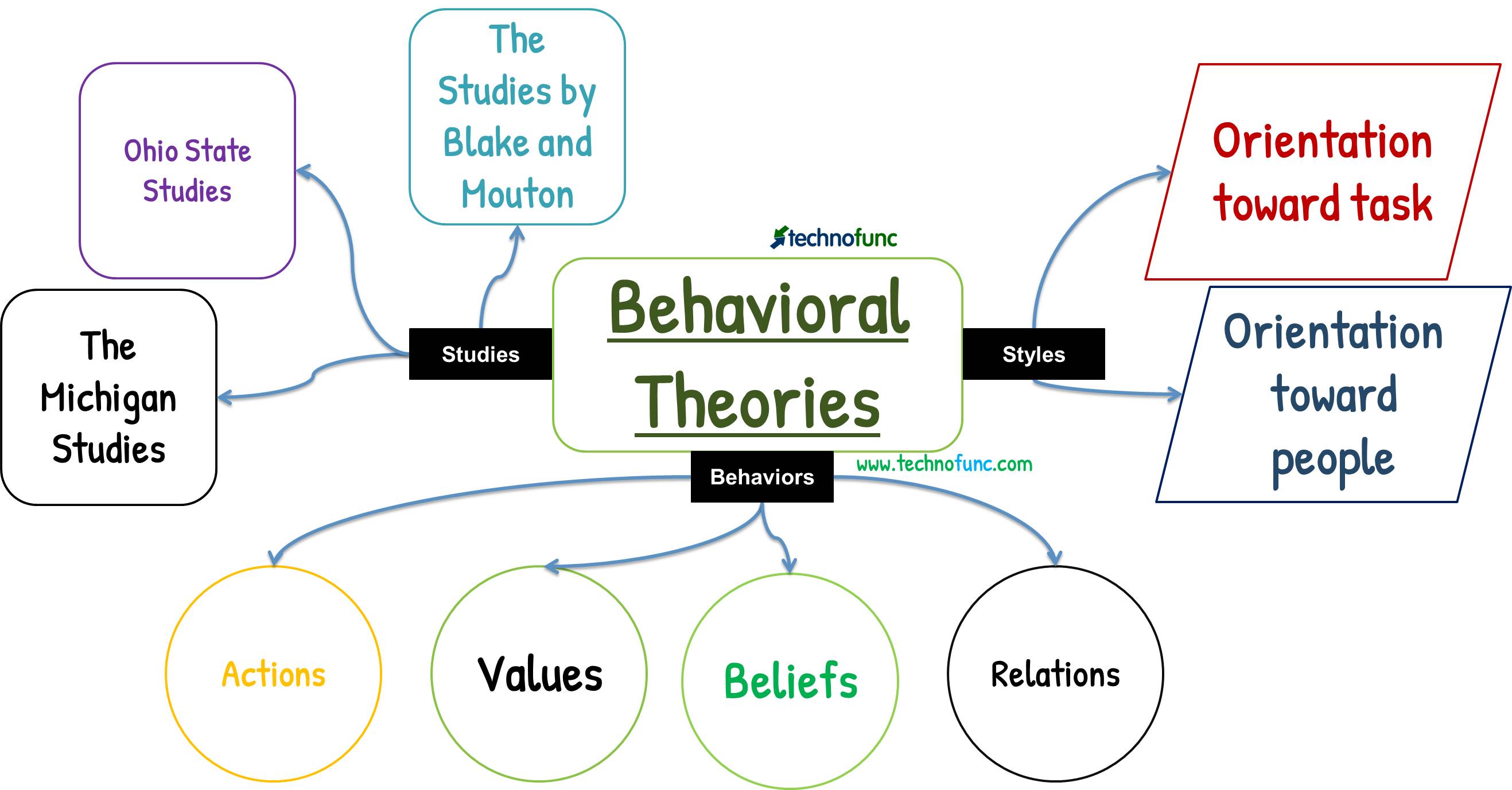- Home
- Business Processes
- Industry Knowledge
- Aerospace Industry
- Automotive Industry
- Banking Domain
- BFSI Industry
- Consumer/ FMCG Industry
- Chemicals Industry
- Engineering & Construction
- Energy Industry
- Education Domain
- Finance Domain
- Hospitality Domain
- Healthcare Industry
- Insurance Domain
- Retail Industry
- Travel and Tourism Domain
- Telecom Industry
- Leadership Skills
- eLearning
- Home
- Leadership
- Change Management
- Behavioral Theories of Leadership
Behavioral Theories of Leadership
Behavioral Theory of leadership is a big leap from Trait Theory, as it was developed scientifically by conducting behaviour focused studies. The theory emphasizes that leadership capability can be learned, rather than being inherent. This theory is based on the principle that a leader's behaviors can be conditioned in a manner that one can have a specific response to specific stimuli.
Behavioral Theories of Leadership, also known as “The style approach to leadership” focuses on the behavior of the leader and what leaders do and how they act. In the 1940s, two parallel studies on leadership were in progress, one based on traits displayed by leaders, another on the behaviours exhibited by leaders.
- Traits theory assumes that leaders are born, rather than made
- Trait theory concentrates on, what the leaders are
- Great Man Theory and Traits Theory are focused on intrinsic personal characteristics
- Behavioural theories are based upon the belief that great leaders are made, not born
- Behavioural theories concentrate on, what leaders do
- Behavioral approach is based on the leader's beliefs, values, and interpersonal relations
- Considers the Leader's attitude, behavior, opinion, and concern about his followers/organization
- Studies leadership behavior from the point of view of motivation, supervision, and authority
- Behavioural theories assume that specific behavioral patterns of leaders can be acquired
- People can learn to become leaders through teaching and observation.
What are Behaviors?
Behavior is the range of actions and mannerisms made by organisms, systems, or artificial entities in conjunction with their environment, which includes the other systems or organisms around as well as the physical environment.
What is Human Behaviors?
Human behavior refers to the range of behaviors exhibited by humans and which are influenced by culture, attitudes, emotions, values, ethics, authority, rapport, hypnosis, persuasion, coercion and/or genetics. In humans, behavior is believed to be controlled primarily by the endocrine system and the nervous system. Behaviors can be either innate or learned.
Human behavior is experienced throughout an individual’s entire lifetime. It includes the way they act based on different factors such as genetics, social norms, core faith, and attitude. Behavior is impacted by certain traits each individual has. The traits vary from person to person and can produce different actions or behavior from each person.
As the questions about how to measure traits continued to challenge trait theory, researchers began thinking about measuring behavior. While you can’t easily measure confidence or honesty in a person, they noted, you can define a behavior or a set of behaviors that seem to embody the trait.
Beliefs are ideas that people have about the world around them and how it operates. People tend to behave according to their beliefs. Values are assessments of the goodness or badness of various features of one's life. Values form attitudes that guide a person's conduct. Beliefs and values have close interaction. Beliefs become values when they lead to certain favorable or unfavorable consequences.
Researchers define behaviors as observable actions, which makes measuring them more scientifically valid than trying to measure a human personality trait. In this theory, we will focus on two general kinds of behaviors by leaders called task behaviors and relationship behaviors.
What is Behavioral Theory of Leadership?
Behavioral Theory of Leadership is a leadership theory that considers the observable actions and reactions of leaders and followers in a given situation. Behavioral theories focus on how leaders behave and assume that leaders can be made, rather than born, and successful leadership is based on definable, learnable behavior. Behavioral theories of leadership are classified as such because they focus on the study of specific behaviors of a leader. For behavioral theorists, a leader behavior is the best predictor of his leadership influences and as a result, is the best determinant of his or her leadership success.
These theories concentrate on what leaders actually do rather than on their qualities. Different patterns of behavior are observed and categorized as 'styles of leadership'. This area has probably attracted the most attention from practicing managers.

Quotes on behaviors:
“No one really knows why humans do what they do.”
David K. Reynolds
“If you want to change attitudes, start with a change in behavior.”
William Glasser
““Behavior is the mirror in which everyone shows their image.”
Johann Wolfgang von Goethe
“It's better to hang out with people better than you. Pick out associates whose behavior is better than yours and you'll drift in that direction.”
Warren Buffett
Overview of Behavioral Theory of Leadership:
Behavioral Theory of leadership is a big leap from Trait Theory, in that it assumes that leadership capability can be learned, rather than being inherent. This theory is based on the principle that behaviors can be conditioned in a manner that one can have a specific response to specific stimuli. Rather than seeking inborn traits this theory looks at what leaders actually do by studying their behaviors in response to different situations, assessing leadership success by studying their actions, and then correlating significant behaviors with success.
The practical application of the theory is that leader’s behavior affects their performance and different leadership behaviors could be appropriate at different times. The best leaders are those who have the adaptability to flex their behavioral style and choose the right style suitable for each situation.
According to this theory, people can learn to become leaders through teaching and observation and certain behavioral patterns may be identified as leadership styles.
Advantages of Behavioral Theory of Leadership:
Behavioral theory promotes the value of leadership styles with an emphasis on concern for people and collaboration. It promotes participative decision making and team development by supporting individual needs and aligning individual and group objectives.
It helps managers evaluate and understand how their behavioral style as a manager affects their relationship with the team and promotes commitment and contribution towards organizational goals.
This theory helps managers find the right balance between different styles of leadership, and helps them decide how to behave as a leader, depending on concerns for people and for productivity.
Criticism / Arguments against - Behavioral Theory of Leadership:
As there were inherent limitations with the Trait approach to leadership, when early researchers ran out of steam in their search for traits, they turned to what leaders did, how they behaved, and came with behavioral theory of leadership. This became the dominant way of approaching leadership within organizations in the 1950s and early 1960s but this theory too had its own limitations.
Behavioral Theory of Leadership proposes leadership styles but a specific leadership style may not be best in all circumstances. When researchers really got to work on this it didn’t seem to validate their assumptions. While behavioral theories may help managers develop particular leadership behaviors but they provide little guidance as to what constitutes effective leadership in different situations.
There were lots of differences and inconsistencies between studies. It was difficult to say which style of leadership was significant in enabling one group to work better than another. The styles that leaders can adopt are far more affected by those they are working with, and the environment they are operating within than had been originally thought. Most researchers today conclude that no one leadership style is right for every manager under all circumstances.
Two Important Behavioral Studies:
The first and foremost study on leadership was carried out by a psychologist, Kurt Lewin, and his associates in 1939 and identified different styles of leadership, viz. autocratic, democratic, and laissez-faire leadership. Subsequently, many research studies could be categorized under the heading of the behavioral approach leading to the identification of various leadership styles and their correlation with measures of effectiveness. The following three studies are strongly representative of the ideas in this approach:
By looking closely at each of these groups of studies, we can draw a clearer picture of the key concepts and implications of the style/behavioral approach to leadership.
Of these three the two Key Studies in behavioral theory at the University of Michigan and Ohio State University became famous in the next generation of leadership research. These studies identified two key behavioral categories
- Orientation toward task: Task behaviors facilitate goal accomplishment and help the team to achieve its objectives.
- Orientation toward people: Relationship behaviors help team members feel comfortable with themselves, with each other, and with the situation in which they find themselves.
List of Behavioral Theories:
Given below is a list of theories and articles that are also classified under behavioral theories or should be read to understand behavioral theories:
- Action Centered Leadership
- Continuum of leadership
- Four Factor Leadership Theory
- Freud Personality Types
- Functional leadership theory
- Iowa Studies
- Jung Personality Types
- Katz’s Three-Skill Approach
- Lewin’s Change Management Model
- Likerts Management System
- Managerial Grid Theory
- McGregor's Theory X and Theory Y
- Michigan Studies
- Ohio State Studies
- Psychodynamic Approach
- Skills Approach to Leadership
Related Links
You May Also Like
-
Participative Leadership Theories
Participative leadership theories rely on the involvement of different participants and suggest that the ideal leadership style is one that takes the inputs of others into account. Participative leaders encourage participation and contributions from group members and involve them in the decision-making process. Participative leadership tries to achieve through people, teamwork and collaboration.
-
Symbolic Interaction and Social Change
George Herbert Mead, an American philosopher, affiliated with the University of Chicago founded the theory of symbolic interactionism. A major aspect of this is that people interact by symbols both verbal and non-verbal signals and every interaction makes a contribution to the mental make-up of the mind thus every interaction with someone, changes you and you go away a different person signifying that humans and change go together.
-
What are the functions which a leader does to establish as a leader? What are the activities undertaken by them to become great leaders, rather revolutionary leaders? The most important tasks done by a leader in all situations are defining the vision, mission, and goals, leading the team, administrative functions, motivating followers, decision making and conflict resolution, and continuous development.
-
Blake and Mouton Managerial Grid is a style leadership model that identified five manager styles based on two dimensions viz concern for people and the concern for production. Managerial Grid uses concern for production style which is largely based on McGregor's Theory X.
-
The cognitive resource theory states the influence of the leader's resources on his or her reaction to stress. The cognitive resources of a leader are experience, intelligence, competence, and task-relevant knowledge. Stress is common in resource managing situations, and this cognitive theory emphasizes how intelligence and experience are each best under different stress situations. This theory is the reconceptualization of the Fiedler model.
-
Contingency Theories of Leadership
Contingency theories of leadership focus on both the leader's persona as well as the situation/environment in which that leader operates. These theories consider the context of leadership which means whether or not the leadership style suits a particular situation and states that a leader can be effective in one circumstance and a failure in another one. A leader will be most effective when he applies the right leadership style to a given situation and environment around him. Contingent leaders are flexible and adaptable.
-
David Kolb produced this popular model for learning in 1984. The model suggests four stages of learning which most learners go through in order to learn effectively. Leaming is itself a process of change. Something is added to our perception and prepared us for the next impression, which will change our understanding yet more, however minutely. The Kolb contribution is a significant one because it practically equates change and learning.
-
McGregor's Theory X and Theory Y
McGregor created Theory X and Theory Y of human work motivation and explained two styles of management known as authoritarian (Theory X) and participative (Theory Y). Theory X management assumes most people will attempt to avoid work whereas Theory Y managers trust their people to take ownership of their work.
-
The Leader-Member Exchange Theory (LMX), also called the Vertical Dyad Linkage Theory is a relationship-based approach that focuses on the two-way (dyadic) relationship to get the best from all team members. How leaders maintain their position in groups and develop an exchange with each of their subordinates. How leaders and members develop relationships that can contribute to growth or hinder development.
-
There are four characteristics of leadership that help us to understand the character of leadership as a concept. 1. Leadership is a process, 2. Leadership involves influence, 3. Leadership always occurs in a group context and 4. Leadership involves goal attainment. These are the four components that make up the character of the 'leadership' term and help us to define the leadership concept. All of these components of leadership have common characteristics.
Explore Our Free Training Articles or
Sign Up to Start With Our eLearning Courses

About Us
Learning
© 2023 TechnoFunc, All Rights Reserved










